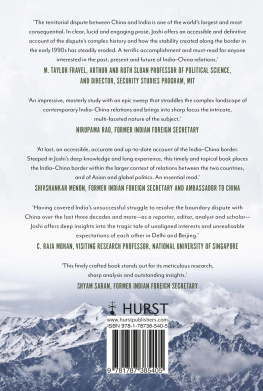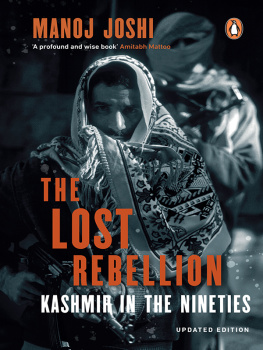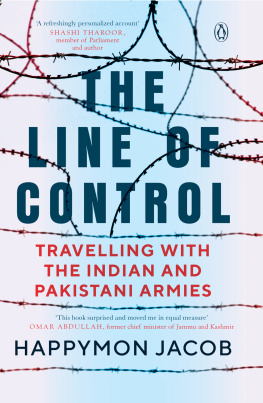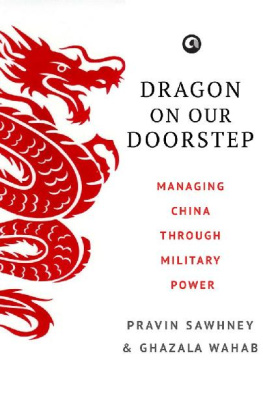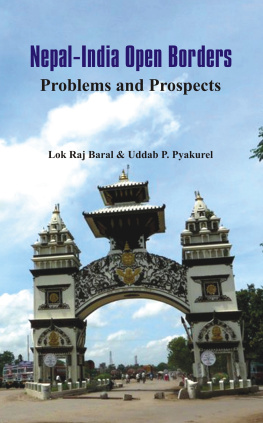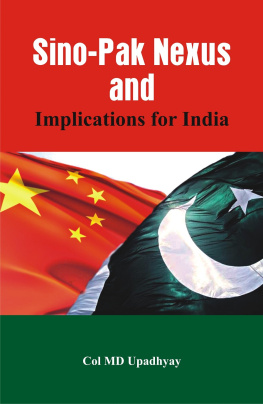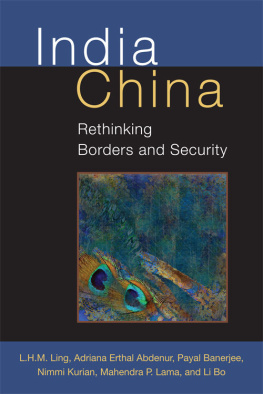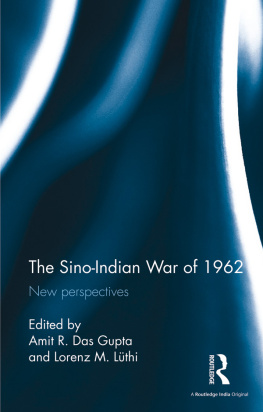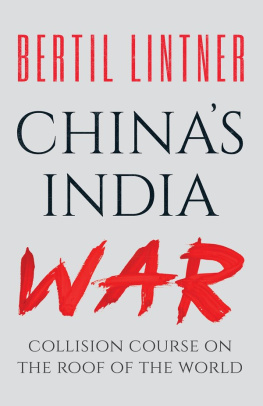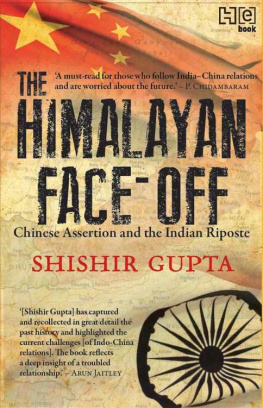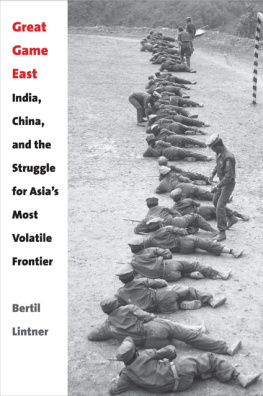
An impressive, masterly study with an epic sweep that straddles the complex landscape of contemporary IndiaChina relations and that brings into sharp focus the intricate, multi-faceted nature of the subject. Joshis investigative outlook, his deep knowledge of the issues involved and their strategic nature, together with his objectivity and clarity of assessment, combine to make for a work of outstanding scholarship.
Nirupama Rao, former Indian Foreign Secretary, and author of
The Fractured Himalaya: India, Tibet, China, 19491962
At last, an accessible, accurate and up-to-date account of the IndiaChina border. Steeped in Joshis deep knowledge and long experience, this timely and topical book places the IndiaChina border within the larger context of relations between the two countries, and of Asian and global politics. Coming when IndiaChina relations are poised at the crossroads and could go either way, this book is an essential read.
Shivshankar Menon, former National Security Adviser, Foreign Secretary and
Ambassador to China, and author of Indian and Asian Geopolitics: The Past, Present
In a field already crowded with several works on the IndiaChina border issue, this finely crafted book stands out for its meticulous research, sharp analysis and outstanding insights. Joshi has skilfully used the prism of the border issue to explore the possible trajectory of IndiaChina relations in a vastly altered geopolitical landscape, lending to the books contemporary relevance.
Shyam Saran, former Indian Foreign Secretary,
Prime Ministers Special Envoy on Nuclear Affairs and Climate Change and author of
How India Sees the World: Kautilya to the 21st century
The territorial dispute between China and India is one of the worlds largest and most consequential. In clear, lucid and engaging prose, Joshi offers an accessible and definitive account of the disputes complex history and how the stability created along the border in the early 1990s has steadily eroded. A terrific accomplishment and must-read for anyone interested in the past, present and future of IndiaChina relations.
M. Taylor Fravel, Arthur and Ruth Sloan Professor of Political Science, and Director,
Security Studies Program, Massachusetts Institute of Technology
Having covered Indias unsuccessful struggle to resolve the boundary dispute with China over the last three decades and moreas a reporter, editor, analyst and scholarJoshi offers deep insights into the tragic tale of unaligned interests and unrealisable expectations of each other in Delhi and Beijing.
C. Raja Mohan, Visiting Research Professor, Institute of South Asian Studies,
National University of Singapore
UNDERSTANDING THE INDIACHINA BORDER
MANOJ JOSHI
Understanding the
IndiaChina Border
The Enduring Threat of War
in High Himalaya

HURST & COMPANY, LONDON
First published in the United Kingdom in 2022 by
C. Hurst & Co. (Publishers) Ltd.
New Wing, Somerset House, Strand,
London, WC2R 1LA
Manoj Joshi, 2022
All rights reserved.
Printed in Scotland.
Distributed in the United States, Canada and Latin America by
Oxford University Press, 198 Madison Avenue, New York, NY 10016,
United States of America.
The right of Manoj Joshi to be identified as the author of this publication is asserted by him in accordance with the Copyright, Designs and Patents Act, 1988.
A Cataloguing-in-Publication data record for this book is available from the British Library.
ISBN: 9781787385405
This book is printed using paper from registered sustainable and managed sources.
www.hurstpublishers.com
All maps by Spatial Technologies, Faridabad
CONTENTS
For the one person who matters more to me than anyone else, Mandira Mitra
ACKNOWLEDGEMENTS
This book is the outcome of three decades of reporting, writing and commenting on China and the IndiaChina border in particular. I would like to thank Hurst for giving me the opportunity to put it all together in what, I hope, is a useful and coherent narrative. Michael Dwyer has played the role of a publisher as well as editor, and this has been to my benefit. Here I would also like to express my thanks to Daisy Leitch, the Production Director at Hurst, who has helped see the book from the first proofs to its production. This is not an academic study of the SinoIndian border problem, but rather the work of a journalist aimed at both scholars and the interested reader.
Over the years, given the remoteness of the border and the official nature of the SinoIndian discourse, I have relied almost exclusively on official sources and contacts and on news reports. In the past many officials took time to explain the arcana of the border dispute to me. They cannot be named, but I would like to express my appreciation to them. Truth be told, I would not have been able to complete this book in the time I did were it not for the COVID restrictions that have blocked all travel. Working from home was the norm at the Observer Research Foundation (ORF), where I work as a Distinguished Fellow, as well. This also meant a limited access to libraries. Fortunately, my personal collection of documents and books as well as the resources available online proved useful here.
I owe Ambassador Ranjit Singh Kalha, who passed away some years ago, a debt of gratitude. He was the early interlocutor who got me interested in the SinoIndian border dispute in the mid-1980s when he was Joint Secretary (East Asia), at the Ministry for External Affairs, the point man for Indias relations with China. I have cited his book, IndiaChina Boundary Dispute, extensively in mine.
I also owe a debt of gratitude to Pushpindar Singh (Pushy) Chopra, who sadly passed away in 2021 during the second and deadly wave of COVID-19. I can now disclose that I had obtained the manuscript copies of the official war histories of India because of him. Most scholars assume that those being cited are official publications, but that is incorrect: they remain in ready-to-publish form only. Since then, the 1965 and 1971 war histories have been published. Peculiarly, the Ministry of Defence has asserted its copyright, but the editors, now retired from service, have said in the respective Introductions that as such the book does not reflect the view of either the Indian Armed Forces or the Government of India in any manner. However, and this is germane from our point of view, the 1962 war history remains unpublished and available for anyone to view on the internet. Thanks to Pushy.
My interest in China has intensified in the past seven years that I have worked at the Observer Research Foundation (ORF). The Foundation has been generous in allowing me the time and freedom to explore my areas of interest. The ORF has meanwhile transformed itself into a global think tank and I have found that the value of its platform in putting across ideas has been enhanced manifold. I wish to express my thanks to the two drivers of this process: the Chairman of ORF, Sunjoy Joshi, and its President, Samir Saran. I would also like to express my appreciation to all my ORF colleagues for providing the collegial atmosphere that has shaped the writing of this book and to offer special thanks to the Foundations librarian, Ms Nisha Verma, for providing me with all the assistance she could, despite the COVID-19 lockdown.
Two experienced China handsformer Foreign Secretary and National Security Adviser Shivshankar Menon, and former Foreign Secretary and Special Envoy of the Prime Minister, Shyam Sarandid me a huge favour by going through an earlier version of my manuscript. I am grateful to them for being kind enough to look at what was then still a very rough draft. Their suggestions have improved the book immensely, but needless to say, they cannot be held to account for any inaccuracies or gaps that may remain. Those are entirely my responsibility. Menon, my senior in college and longtime friend, was kind enough to review my final conclusions and as a result of his advice I re-wrote portions of it. That is a heavy debt. Thanks so much, Shivshankar.
Next page
